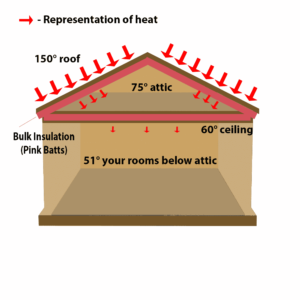Introduction
Before going for the insulation you must know the full details of your building codes and your location.
What is the best way for 2×8 ceiling insulation?
A fantastic technique to increase a building’s energy efficiency and increase the comfort of its residents is to insulate the 2×8 ceiling. Selecting the right R-value for insulation, measuring the thickness, cutting the insulation to fit, putting a vapor barrier to reduce heat and sealing if needed are the few steps to get proper ceiling insulation for your comfortable home.
By following these instructions, you will be able to increase your home’s energy efficiency and comfort while lowering your energy costs.
How To Insulate 2×8 Ceiling?
You can insulate the 2×8 ceiling by yourself. You have to calculate the correct insulation batts to ease your difficulty because if it is not clearly done then your ceiling may lose up to 35% of its heat in the winter and gain the same amount in the summer.
While taking precautions you might need hazet tools where you could get ideas from hazet tools are so expensive. Starting with the insulation process you have to follow a few steps in the right direction.
There are two types of main insulations; batt and reflective foil. If your ceiling is flat and your roof is pitched with metal or tiles then insulation batts or blankets are your best option for ceiling insulation.
Bulk insulation or batts shouldn’t be compressed because doing so will limit the air pockets and its insulating properties will be lost. As loose fill that is pumped or blown into the space that needs insulation, bulk insulation is also available in the form of batts, blankets, and boards.
 Source: Bulk Insulation (Batt/blankets)
Source: Bulk Insulation (Batt/blankets)
These are pre-cut insulation pieces that are often made of fiberglass, though there are additional variations made of cellulose, mineral wool, natural fibers, and plastic. The finest insulation for unfinished walls, floors, and ceilings is this kind of insulation.
Foil is an excellent vapor barrier. However, it should not be used on the outside of a wall in cold climates. This is because it traps moisture and causes rot, and it is not breathable.
Rockwool, also known as Roxul, is a reliable insulation material because it does not trap moisture like some foam insulation types can. Spray foam is also an option, but it is more expensive.
It is not necessary to cut rockwool to fit as it is available in rigid and batt insulation with the appropriate sizes. You can go through this video How Much Insulation Do You Need? to get a clear vision. How Much Insulation Do You Need?
 Source: Rockwool
Source: Rockwool
Here are the steps to follow for 2×8 ceiling insulation;
Step 1: Choosing The Size Of Insulation
To insulate a 2×8 ceiling, it’s important to choose the right size of insulation. 2×8 batts are recommended for better insulation, and R-19 is suitable for this type of ceiling.
If you’re on a budget, you can also consider adding R-19 to your ceilings, especially if you don’t frequently use your garage.
However, if your roof is closed and the heat is unbearable, it’s best to avoid using R-19 insulation. R-25 is the best option for a 2×8 roof, as it provides better insulation and can fully cover the limited height of 7-14 inches.
While R-30 insulation is cheaper, some people believe that fiberglass can become compressed. It’s also important to consider adding vents to improve ventilation. Remember that a higher R-value indicates better insulation.
Step 2: Thickness For Insulation In The Ceiling
The exact dimensions of the two-by-eight joists are 7 1/4 inches by 1 1/2 inches. The distance between the centers of each joist during standard joist construction is 16 inches, or from one joist center to the next.
| Factors | R-19 | R-25 | R-30 |
| Thickness | 6” | 8.25″ | 8¼ ” |
The space between the joists is now 15 inches. Fiberglass R-19 batt insulation is the ideal size for insulating a two-by-eight floor joist system because it is approximately 6 inches thick and comes in 15-inch widths.
Step 3: Fitting Joists
Now, you have to think about fitting the insulation. So, to fit the ceiling joists you must cut the insulation to cover the area and place it.
Step 4: Using Vapor Barriers
To reduce moisture infiltration, it’s recommended to use vapor barriers for the walls and ceiling. These barriers are typically installed on the inner surface of the exterior wall. You will get a clear idea from Wall and Ceiling Vapor Barriers.
Step 5: Gapping Batts
If you are worried about problem with the “gap” or empty space between the two batts. Then you have to seal those gaps through caulk or expanding foam. Use a caulk gun to apply caulk to the edges of the batts.
Make sure the caulk is applied evenly and completely. If the gap is large, you may need to use expanding foam.
Tips For 2×8 Ceiling Insulation
- If you struggle with outside noise then for giving the width, heavier insulation materials like rock wool between the walls often perform well at reducing noise.
- The higher the STC rating, the better the partition can block sound. STC ratings are typically used to rate interior partitions, ceilings, floors, doors, and windows. So go for a insulation with high STC rating.
- Ask your electrician for advice to make sure the wiring can be concealed. Make sure that any work the electrician performs won’t affect how well the insulation was installed.
To get a deeper understanding of wiring, you take the idea from building a garage over buried power lines.
FAQs
Is It Possible For Insulation To Be Thicker Than Joists?
Yes, it is possible for insulation to be thicker than joists. According to the Chicago Tribune, insulation that is thicker than the depth of the ceiling joists should consist of two or more layers.
Does The Insulation In Ceilings Require A Vapor Barrier?
Yes, most climates require vapor barriers to cover ceiling insulation, but not all insulation requires them. Always check your state’s building codes before starting any project. Regardless of whether an attic is vented or unvented, an air barrier should be installed such as an airtight drywall ceiling in all climates.
How Long Does Ceiling Insulation Last?
Every 15 to 20 years, insulation should be updated or modified. However, depending on the type of insulation placed, the original insulation’s R-value, compression and displacement over time, and the presence or absence of damage, it can require replacement or modification sooner.
Conclusion
To conclude, following these steps for the 2×8 ceiling insulation would increase the effectiveness of your HVAC systems and keeps the temperature in the house during the summer and winter season. Wish you all the best.



